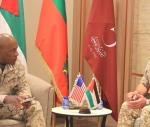You are here
The cycle of Syrian-Arab relations as context for the latest breakthrough
May 21,2023 - Last updated at May 21,2023
There is no doubt that the return of Syria to the Arab League and the participation of President Bashar Al Assad personally in the recent summit in Saudi Arabia appears to be a unique breakthrough. However, this is not the first time that Arab countries, especially the Gulf, have reengaged with Assad after a long break. This happened immediately after the assassination of former prime minister Rafic Hariri in 2005 and the embargo mostly imposed on Assad that was then broken by the late Saudi King Abdullah who made his official visit to Syria in 2009.
Prior to that, in the 1980s, the conflict between Syria and Gulf countries, mainly Saudi Arabia, reached its peak after disputes over the first draft of Arab Peace initiative that the Saudis proposed in 1981 at the Arab Summit in Morocco. This long dispute was ended with a surprise change in the Syrian position after Saddam Hussein’s invasion of Kuwait in 1990, when Assad supported the Gulf Countries and sent his troops to be part of the international coalition to free Kuwait.
Given the long history of ups and downs with Assad, his return to the Arab League is not particularly surprising, rather the long-term success of this re-engagement would be most surprising. This is especially so, as Syria’s return to the fold is predicated on a series of steps in must take on the ground to prove its good intentions towards its Arab neighbours given the wider scene of regional competition and problems such as drugs and weapons trafficking and the presence of non-state actors and militias.
Further, Syria and Assad’s return to the Arab League after 12 years may signal the reintegration of Syria at the Arab level, but the real challenge is reintegration into the international community. This would include lifting of sanctions and the Caesar Syria Civilian Protection Act to achieve a full re-integration. This is the real challenge of the next phase, particularly for the Arab allies of the US, which have played a major role in bringing Syria back into the Arab League.
International reintegration definitely requires a clear road map and guarantees from Syria itself, and requires concrete steps taken by Syrian regarding a plan for a political solution and to resolve problems such as refugees, and integrating the political opposition. These are critical elements required to shift Syria’s current status at an international level and a key step that Arab countries will be invested in as the process of rebuilding Syria is not possible without the removal of sanctions. The Arab countries will need to work with Syria to influence and convince the US and the international community that this approach will make a change on the ground in Syria.
The return of Syria into the Arab League represents the first step in a potential break through of the continuous crisis that has been disastrous for the whole region, so taking steps to finding solutions and giving Syria the chance to collaborate to achieve changes is the only practical solution. However, the capacity to achieve solutions for the current challenges around drugs, weapons trafficking and pro-Iran militias will truly decide how the relations between Arabs and Syria will evolve in the longer term.













